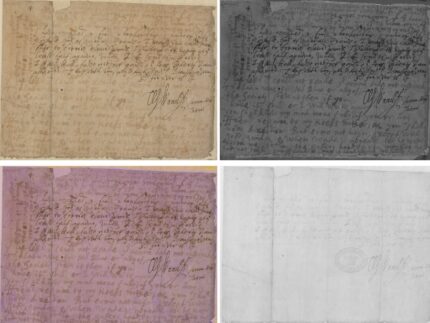Happy Guy Fawkes Day! To commemorate the 415th anniversary of the Gunpowder Plot, the UK National Archives has posted a great blog about how they’ve used their new multispectral imaging system on letters between the plotters that has secret messages written in orange juice. Just like the lemon juice letters of many of childhoods, the orange juice letters fade when they dry only to reappear again when the paper is heated.
Four centuries after they written, some of the secret ink letters are hard to read with the naked eye. Imaging in non-RGB areas of the electromagnetic spectrum like ultraviolet and infrared can drastically increase readability of the once-invisible ink.

Both inks are visible in a RGB colour photograph to varying degrees (top left) but imaging in the ultraviolet (UV) region of the electromagnetic spectrum increases the readability of the orange juice (top right).
To image this way, the letter is illuminated with UV light and the reflected UV light is recorded. Both the orange juice and iron gall ink absorb UV light, making the inks appear darker. Reflectance images appear on a greyscale but by combining a RGB colour photograph with a UV reflectance image we can create a false colour image (bottom left). These images keep the luminance of the UV image and blend it with the hue and saturation of the RGB colour photo, allowing for a more intuitive reading of the information on the letter.
The final image I took was an image in the infrared (IR) region of the electromagnetic spectrum (bottom right). Imaging in the IR region is frequently used to reveal underdrawings and concealed features. This is because the radiation penetrates deeper into the material and many materials, like organic pigments, become transparent.
In the IR region the orange juice completely disappears because it is an organic material. However the iron gall ink which contains iron salts is still partly visible, enabling us to clearly distinguish the two types of inks.
Another Guy Fawkes-themed offering from the National Archives is this podcast from 2009 which tells the story of the Gunpowder Plot and the subsequent investigation using a selection of documents from the archives to explore events from the perspective of eye witnesses.
Last but not least is an absolutely devilish online jigsaw puzzle of Guy Fawkes’ confession letter.
Incidentally, just in case you happen to be in the market for a number of soothingly distracting rabbitholes to fall into, the National Archives has tons of great video and audio content. I first discovered got into it in August when I watched the Stinking Fish, Beer and Brewing Controversies around 1800 live webinar which was even more interesting and entertaining than the title already suggested it would be. Since then, I’ve been going through their archived video and audio and there isn’t a dud in the bunch. The Film of the Month and What’s Online features tend to be my favorite videos, but it’s all gold, and the podcasts may well be the most information-rich ones I’ve ever heard. There are entire conferences from keynote addresses to panel sessions available, and the podcasts cover everything from topical issues to how to use public records — wills, census data, birth/marriage/death registers — to the curse(s) of Tutankhamun.
